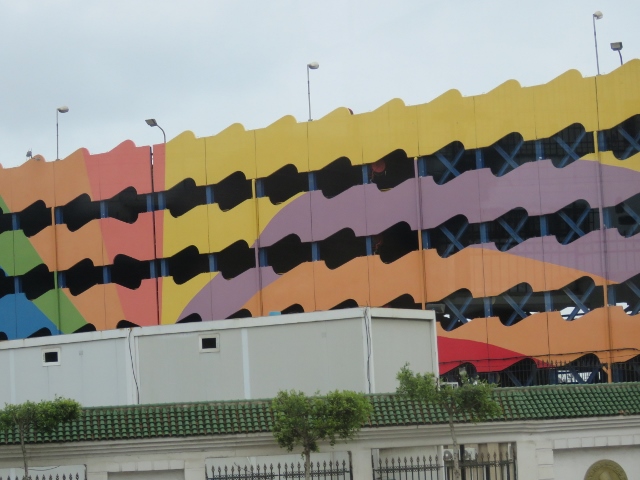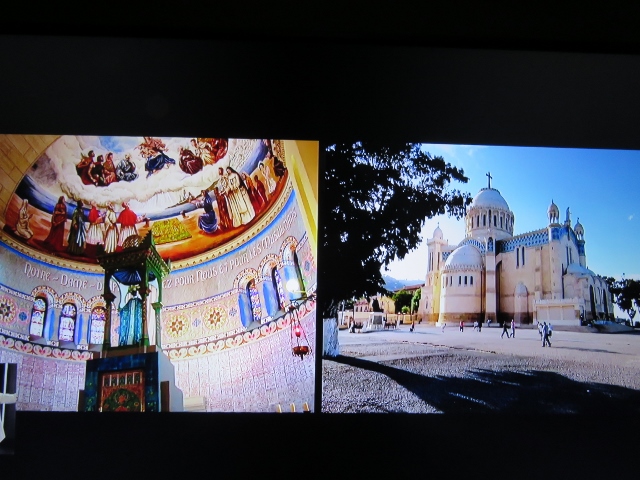Friday, April 27, 2018, Algiers
Known
as “Alger la Blanche” for its white buildings gleaming on the Mediterranean,
Algiers is a heady mix of ancient and modern.
Today’s bustling city hugs the shore and boasts many gracious French
accents from colonial days such as the Grand Poste and generous wide boulevards
and gardens. District from the city’s
pre-colonial Ottoman past rise from the coast upon the slopes of the hillside
beyond. The city’s pinnacle of historic
splendor, Agliers’ casbah, crowns this hilltop.
It is North Africa through and through, a maze of stone warrens offering
an ideal setting to pause for mint tea and kebabs.
Peel
back layers of history—French, African, Ottoman—in the spellbinding
Mediterranean city of Algiers. Explore the Parisian-flavored modern city, a pre-colonial
Ottoman past and the hilltop casbah.
Impressions Of Algiers
We got acquainted with
Algiers’s Berber, Arabic, and French heritage on this motor-coach tour of key
historic sites. We first rode to the
302-foot-high Martyrs Monument. Dedicated to the heroes of Algeria’s 1954–1962
War of Independence against France: It takes the shape
of three giant, stylized palm leaves sheltering an eternal flame at the base. We stopped for a photo to capture commanding
views of the Casbah and Bay of Algiers. Next
we rode through the city center to see La Grande Poste, built by the French in
1920. Massive turrets, keyhole doors,
and elegant neo-Moorish fittings (including an opulent mailbox) make it one of
the city’s most whimsical modern buildings; it is currently being modified to be a museum.
We enjoyed a brief photo stop before we continued riding along the
Parisian-style boulevards of the French Quarter, toward the busy Bab El Oued
district. We glimpsed the imposing
Basilica of Notre Dame D’ Afrique (Our Lady of Africa), seen by many as a
symbol of religious tolerance, before returning back to our ship.
Ours was only the third cruise ship (two Viking cruise ships a year ago) to make a port call in Algiers so we were quite a novelty. Cell phones worked overtime!
Very colorful as we began our shore excursion.
An upscale home.
Typical apartment building.
One of the most recognizable landmarks in the city, the Makam Echahid celebrates the sacrifice of the unknown martyr who fell for his country. The monument, constructed by the Canadians in the early 1980s, is made up of three massive concrete palm fronds that come together and soar 92 meters into the sky, representing the coming together of agriculture, culture and industry to make independent Algeria great.
At the base of each palm frond is a soldier of various branches.
Below the base of the Makam Echahid is a museum.
Algiers war museum.
Head stones of Allied World War II dead of Africa campaigns.
Working guillotine left over from French occupation.
Algiers botanical garden.
The Test Garden of Hamma is a 140-acre botanical garden (94 acres) of gardens and 49 acres of arboretum located in the Mohamed
Belouizdad district of Algiers. It was established
in 1832.
Between
2001 and 2009 the garden was closed for restoration work. Reopened in 2009, it is now home to the Algerian National Institute of Agronomical Research,
and was opened to visitors. There are
currently an estimated 1,200 different species of plant in the garden.
Portion used for Tarzan movie from the 1930s.
The Casba (on horizon about 1/3 of the way from right edge of picture).
Fountain in the center of a round-a-bout.
Notre Dame d'Afrique (Our Lady of Africa), also known as Lalla Meriem or Madame l'Afrique, is a Roman Catholic basilica in Algiers, Algeria. It was Louis-Antoine-Augustin Pavy, who served as
the Bishop of Algiers from 1846 to 1866, who paved the way for its construction.
The basilica was
inaugurated in 1872, after fourteen years of construction. It was founded by Charles
Lavigerie. Its architect, Jean-Eugène Fromageau, who had been appointed
the chief architect for ecclesiastical buildings in French Algeria in
1859, employed a Neo-Byzantinestyle. Its floor plan
is unusual as the choir is situated on the southeast instead
of the usual east side of the building.
The basilica contains 46 stained glass windows installed in the 19th century. They were blown out during a bombing of the area in April 1943 and have been restored twice since the end of World War II. The basilica was damaged by the 2003 Boumerdès earthquake. A reconstruction project was initiated by Archbishop Henri Teissier in 2003, but work on the project didn't start until the spring of 2007. The total cost of restoration was 5.1 million euros. The project took three years to complete.
Research hospital.
French post office building. Closed for remodeling to a museum.
Typical letter drop for the French post office.
Mosque clock tower. Date palms in foreground.
Dates; yum!
Street closed on Fridays and Saturdays to provide play space for children.
Third largest mosque in the world. Two largest are in Saudi Arabia.
These charts were presented by one of our visiting guest lecturers.




























































Comments
Post a Comment